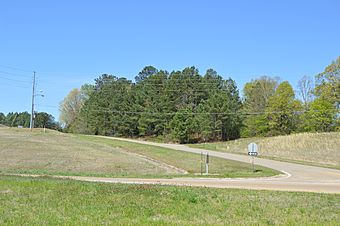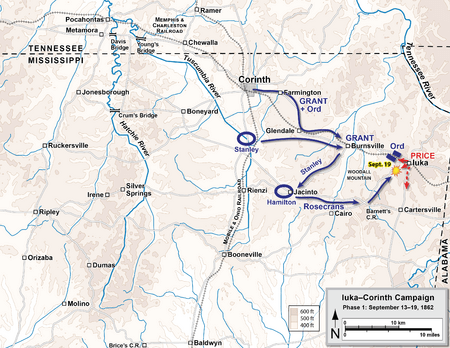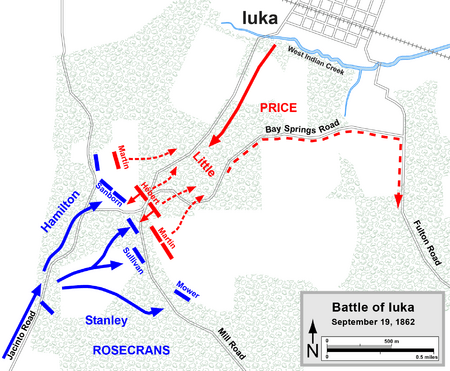Battle of Iuka facts for kids
Quick facts for kids Battle of Iuka |
|||||||
|---|---|---|---|---|---|---|---|
| Part of the American Civil War | |||||||
 Battle of Iuka, Miss., September 19, 1862 |
|||||||
|
|||||||
| Belligerents | |||||||
| Commanders and leaders | |||||||
| William Rosecrans | Sterling Price | ||||||
| Units involved | |||||||
| Army of the Mississippi | Army of the West | ||||||
| Strength | |||||||
| ∼ 4,500 | 3,179 | ||||||
| Casualties and losses | |||||||
| 790 total
(144 killed;
598 wounded; 40 captured/missing) |
1,516 total
(263 killed;
692 wounded; 561 captured/missing) |
||||||
The Battle of Iuka was a key fight during the American Civil War. It happened on September 19, 1862, in Iuka, Mississippi. In this battle, Union General William Rosecrans stopped the advance of the Confederate Army of the West. This Confederate army was led by General Sterling Price.
Union General Ulysses S. Grant planned to trap Price's army. He sent two Union armies to attack Iuka from different directions. Rosecrans's Army of the Mississippi came from the southwest. General Edward Ord led three divisions of Grant's own Army of the Tennessee from the northwest. Grant and Ord planned to attack when they heard Rosecrans's battle begin.
However, a strange weather effect called an acoustic shadow blocked the sound of the fighting. This meant Ord and Grant did not know the battle had started. Rosecrans's men fought alone for the whole afternoon. After the battle, the Confederates left Iuka. They used a road that the Union army had not blocked. Price's army then joined up with another Confederate general, Earl Van Dorn. Together, they would soon fight Rosecrans again at the Second Battle of Corinth.
Contents
Why the Battle Happened
After the Siege of Corinth in May 1862, General Henry Halleck became the top general for the Union Army. General Ulysses S. Grant took over Halleck's command in Corinth, Mississippi. Grant's forces were busy protecting supply lines in western Tennessee and northern Mississippi.
Meanwhile, Confederate General Braxton Bragg moved his army north into Kentucky. The Confederates wanted to stop Union General Don Carlos Buell from getting help from Grant's army.
Confederate Plans
Confederate General Sterling Price was ordered to move his Army of the West. He was supposed to go from Tupelo, Mississippi towards Nashville, Tennessee. This was to help Bragg's attack in Kentucky. On September 13, Price's army reached Iuka, Mississippi. Iuka was a small Union supply base about 20 miles east of Corinth.
Price's cavalry had a small fight with Union guards there. On September 14, the Union commander, Col. Robert C. Murphy, burned the supplies. He then marched his 2,000 men back to Corinth. The Confederates quickly put out the fires and took many valuable supplies. Rosecrans was angry and had Murphy removed from command.
Price's army stayed in Iuka. They waited for General Earl Van Dorn's Army of West Tennessee to arrive. Van Dorn had about 7,000 men. Price and Van Dorn planned to join forces. They wanted to attack Grant's supply lines in western Tennessee. This would stop Grant from sending help to Buell. Or, it might let them follow Bragg and support his invasion of the North.
Union Response
Grant decided not to wait to be attacked. He approved a plan to surround Price's army before Van Dorn could arrive. Van Dorn was still four days' march away. Grant sent General Ord with about 8,000 men. They would approach Iuka from the northwest.
He also ordered Rosecrans's army to move from the southwest. Rosecrans had two divisions, about 9,000 men. Their job was to block Price's escape route from Iuka. The rest of Rosecrans's army protected Corinth from Van Dorn. Rosecrans had been in Iuka before and knew the area well. He came up with this two-part attack plan. Grant was with Ord's group, but Rosecrans was mostly in charge of his own part of the battle.
Who Fought in the Battle
Union Army Leaders
| Main Union Commanders |
|---|
|
Rosecrans's Union Army of the Mississippi had about 4,500 soldiers.
- General David S. Stanley led a division.
- General Charles S. Hamilton led another division.
- Colonel John K. Mizner led the cavalry.
General Edward Ord's two divisions did not take part in the main fighting at Iuka.
Confederate Army Leaders
| Main Confederate Commanders |
|---|
|
Price's Confederate Army of the West had 3,179 soldiers fighting at Iuka.
- General Lewis Henry Little led a division.
- General Frank C. Armstrong led the cavalry.
The Battle Begins
Ord's Union troops moved towards Iuka on the night of September 18. They had small fights with Confederate guards about six miles from Iuka. Rosecrans was late because his march was longer and the roads were very muddy. One of his divisions even took a wrong turn. On the night of September 18, Rosecrans told Grant he was 20 miles away. He planned to start marching again at 4:30 a.m. and reach Iuka by mid-afternoon on September 19.
Because of this delay, Grant told Ord to get within 4 miles of Iuka. But Ord was ordered to wait until he heard fighting from Rosecrans before attacking. Ord demanded that the Confederates surrender, but Price refused. Price had received messages from Van Dorn suggesting they meet at Rienzi, Mississippi. So, Price told his men to get ready to march the next day.
Rosecrans's army marched early on September 19. They used only one road, the Jacinto Road, instead of two. Rosecrans worried that if he split his forces, they couldn't help each other if attacked.
First Shots Fired
Rosecrans was about two miles from Iuka on September 19. His lead group, Sanborn's brigade, was suddenly attacked by Little's Confederate division. This happened at 4:30 p.m. on the Mill Road. General Hamilton quickly set up his forces. His artillery was placed on the best ground available.
General Hébert's Confederate brigade attacked a Union artillery battery around 5:15 p.m. The Union soldiers fired at them from 100 yards away. The Confederates were pushed back twice. On their third try, the Confederates drove off the Union gunners. They forced the 48th Indiana to fall back. The Union 11th Ohio Battery lost 46 of its 54 gunners. The Confederates captured all six guns, but they couldn't use them. All the horses that pulled the guns had been killed.
At this point, Stanley's division joined the fight. The 11th Missouri was placed to the right of the 5th Iowa. It stopped a final desperate attack by two Mississippi brigades. The fighting was very intense and continued until after dark. Price later said it was some of the best fighting he had ever seen.
The Acoustic Shadow
A strong north wind was blowing from Ord's position towards Iuka. This wind created an acoustic shadow. This meant the sound of the guns could not reach Ord and Grant. They had no idea the battle was happening. Ord's troops stood by, doing nothing, while the fight raged only a few miles away.
What Happened Next
I cannot speak too highly of the energy and skill displayed by General Rosecrans in the attack, and of the endurance of the troops under him. General Ord's command showed untiring zeal, but the direction taken by the enemy prevented them from taking the active part they desired.
If it was the object of the enemy to make their way into Kentucky, they were defeated in that; if to hold their position until Van Dorn could come up on the southwest of Corinth and make a simultaneous attack, they were defeated in that. Our only defeat was in not capturing the enemy army or destroying it as I had hoped to do. It was a part of General Hamilton's command that did the fighting, directed entirely by that cool and deserving officer.
During the night, both Rosecrans and Ord got their forces ready. They expected the battle to start again at daylight. But the Confederate forces had already left. Price had been planning to move since September 18. Rosecrans's attack only delayed his departure. The Confederates used the Fulton Road, which the Union army had not blocked. They protected their rear with a strong group of soldiers. Five days later, they met up with Van Dorn's army in Ripley, Mississippi.
Price's army then joined Van Dorn's for the Second Battle of Corinth. This battle happened on October 3–4. Union General Stanley shelled Iuka, driving out any remaining Confederate soldiers. He and Rosecrans's cavalry chased Price for 15 miles. But Rosecrans's troops were very tired. They could not keep up, so he stopped the chase.
Battle Results
The Union army lost 790 soldiers at Iuka. This included 144 killed, 598 wounded, and 40 captured or missing. The Confederates lost 1,516 soldiers. This included 263 killed, 692 wounded, and 561 captured or missing. The highest-ranking Confederate officer to die was General Little. He was shot in the eye while with General Price.
The Confederates left behind many supplies. These included 1,629 rifles, a large amount of food and other goods, and 13,000 rounds of ammunition. Grant had partly achieved his goal. Price was not able to join Bragg in Kentucky. But Rosecrans could not destroy the Confederate army. He also could not stop it from joining Van Dorn. This meant the Confederates still threatened the important railroad junction at Corinth.
The Battle of Iuka also started a long disagreement between Rosecrans and Grant.
Iuka Battlefield Today
|
Iuka Battlefield
|
|

Part of the field, viewed in 2014
|
|
| Location | N of MS 72, W of MS 25, Iuka, Mississippi |
|---|---|
| Area | 70 acres (28 ha) |
| Built | 1862 |
| NRHP reference No. | 07001184 |
| Added to NRHP | November 14, 2007 |
Historic Site Information
The battlefield site was added to the National Register of Historic Places on November 14, 2007. In 1862, the area was open forest and farmland. Today, it is mostly covered by thick woods and bushes. None of the buildings from the time of the battle are still standing. The Goyer Cemetery still exists. It was near the center of the Union line, but most of the grave markers are gone. Today's Highway 25 is close to where the Jacinto Road was. This road was used by Rosecrans's Union forces.
Protecting the Battlefield
The Civil War Trust (which is part of the American Battlefield Trust) and its partners have worked to save parts of the Iuka battlefield. They have bought and protected about 58 acres of the land where the battle took place.
Images for kids
-
Maj. Gen. Ulysses S. Grant
-
Maj. Gen. William Rosecrans -
Brig. Gen. David S. Stanley -
Brig. Gen. Charles S. Hamilton -
Maj. Gen. Sterling Price











